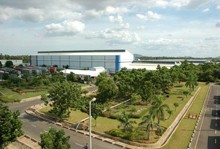Case Study: Zero Water Discharge in Chennai, India

Ford’s production plant in Chennai, India
The Chennai region of India has been likened to “the Detroit of Asia,” thanks to the large number of automotive and vehicle component companies that operate there. As a manufacturing hub, the region is also home to dozens of multinational firms in computers, technology and healthcare, to name a few other prominent industries.
With an estimated population of more than 9 million, the metropolitan Chennai area ranks among the top-four most populous regions in India – and can be counted among the 40 largest metropolitan areas in the world.
But growing industry and burgeoning population have put considerable stresses on a part of the world that already suffered from chronic water scarcity. And the demand for water has quickly outpaced the limited supplies.
Like other auto companies, Ford has been expanding our operations and production in Chennai in an effort to serve one of the world’s fastest-growing auto markets. One challenge, however, has been finding ways to do so without adding to the water burdens of the region.
With pressures on water supplies expected to continue, government authorities have been requiring manufacturers to achieve zero liquid discharge in their operations, as a way to encourage them to reuse water and reduce their overall water use. Our Ford assembly plant in Maraimalai Nagar, 45 kilometers southwest of Chennai, was able to achieve that goal, thanks to an innovative process that treats the plant’s wastewater and recycles it back into our manufacturing processes. Reaching the zero-discharge goal has helped us understand and gain experience with new technologies that are likely to become increasingly important as water scarcity and quality issues grow more urgent around the globe. (Our recently updated water strategy focuses on regions – like Chennai – where water is scarce).
To reach zero liquid discharge, Ford India implemented a combination of physical, chemical and biological treatment operations. Wastewater streams from the assembly and engine plants are individually pretreated before being mixed with sanitary and cafeteria wastewaters. Following biological treatment, the stream passes through media filtration and activated carbon before it is ultrafiltered. This final stream is sent to a three-stage reverse-osmosis system, where it is separated into an ultrapure water phase and highly concentrated brine stage. The brine is distilled until it results in a solid salt, which is disposed of as waste.
Even before our recent upgrades, we were treating nonindustrial wastewater, such as toilet and sink water, for reuse in toilets. Overall, the plant’s water usage is extremely low – the lowest among all of Ford’s plants. In 2011, the plant’s average usage was 1.15 kiloliters (or 1.15 cubic meters) per vehicle.
Chennai Assembly Plant Facts
- Recent investment: $500 million
- Annual production capacity: 200,000 units
- Year opened: 1996
- Year renovated: 2010
- Total employment: about 2,000
- Products: Ford Fusion, Ikon, Fiesta and Endeavour
- Site size: 350 acres
- Per vehicle water reduction: 72 percent per vehicle between 2007 and 2011
- Waste: Zero solid waste facility
- Suppliers on site: Visteon Corporation, TATA Johnson Controls, YAPP Automotive Parts, Cooper
